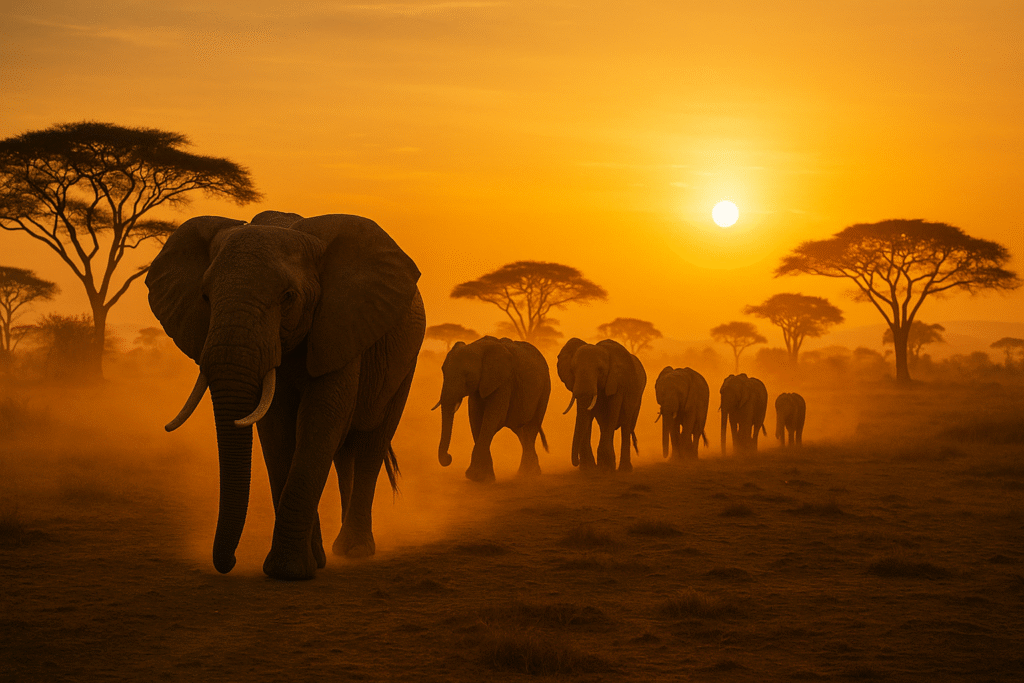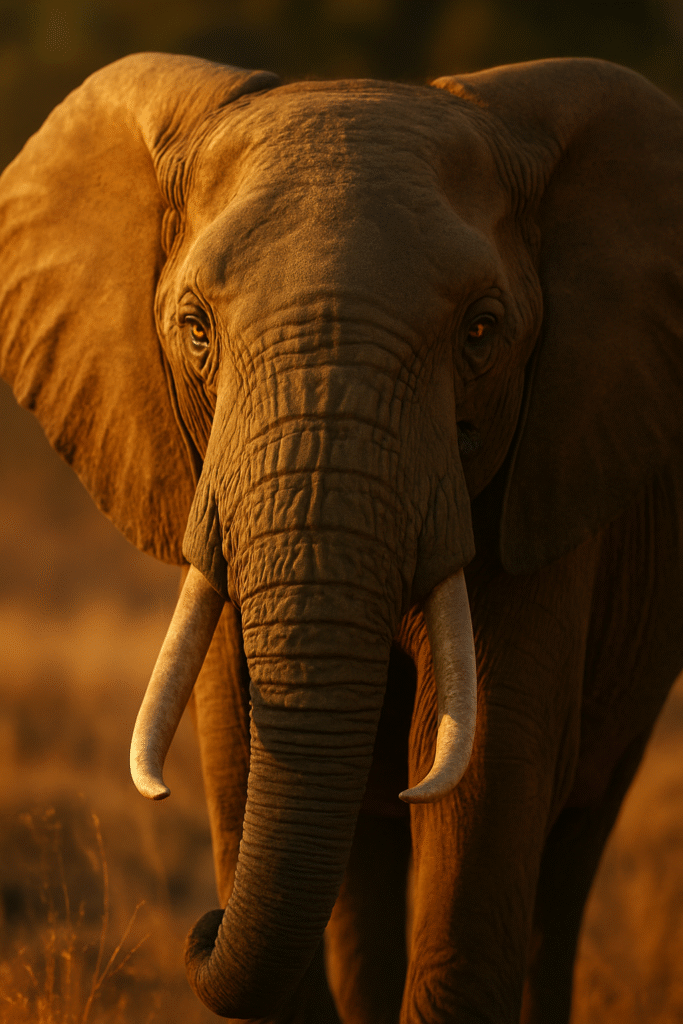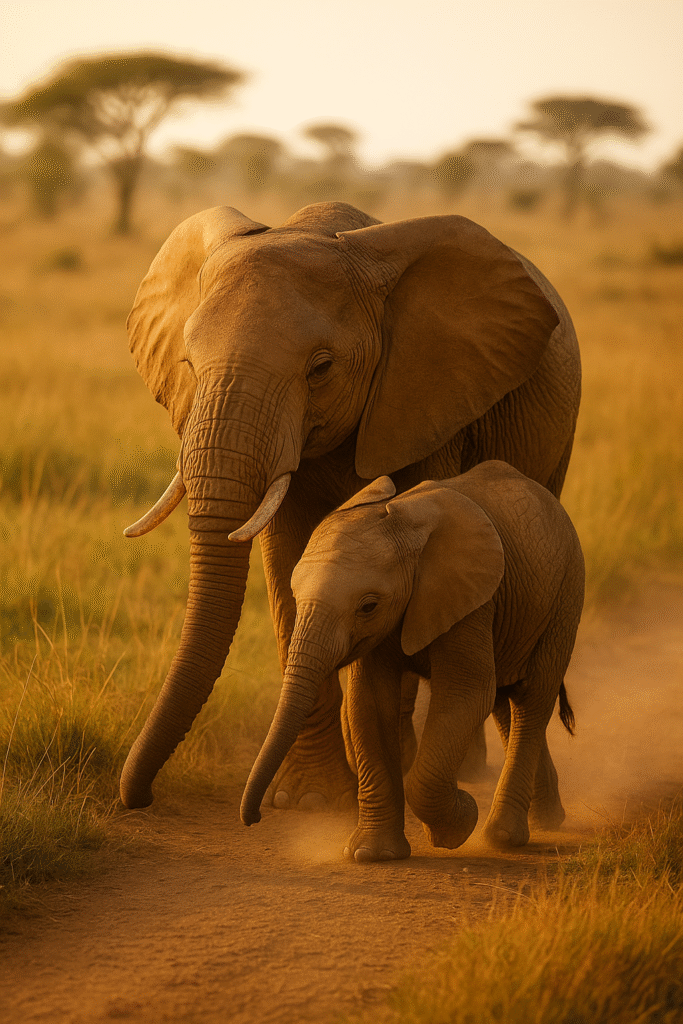A Dawn in the Savannah
The first light breaks across the Serengeti. A hush lingers in the air before the chorus of birds, before the restless stirring of antelope. And then it comes: the low, seismic rumble that precedes them. Out of the haze, a matriarch leads her herd across the dew-silvered grasslands. Her ears sway like banners, her tusks catch the rising sun, and each heavy step impresses the earth with memory. Elephants do not merely walk through the landscape — they shape it, remember it, and, in ways both visible and invisible, bind the past to the present.

These are not just animals. They are architects of ecosystems, subjects of ancient myth, and symbols that carry the weight of human imagination. To encounter an elephant is not simply to see one — it is to be seen, measured, and quietly acknowledged by a creature whose mind has mapped worlds older than our own civilizations.
The Science of the Elephant: Flesh, Bone, and Memory
Biologically, elephants are a marvel of scale and subtlety. The largest land mammals on Earth, African savanna elephants (Loxodonta africana) can weigh up to 12,000 pounds, yet walk with surprising silence, cushioned by padded feet that sense vibrations. Their trunks — nearly 40,000 muscles woven into a single organ — can pluck a blade of grass with delicacy or topple a tree with power.
But it is the mind of the elephant that has astonished scientists most. Their brains, weighing around 5 kilograms, are not just large but unusually complex. Elephants demonstrate episodic memory, recalling the location of distant waterholes across decades. They recognize themselves in mirrors, pass down knowledge across generations, and mourn their dead.
Communication is another realm of wonder. Beyond trumpets and rumbles, elephants use infrasound — sound waves below human hearing — to transmit messages across miles. Some researchers believe they can even detect seismic vibrations through their feet, effectively “listening” to the earth.
Shapers of the Wild: Elephants as Ecosystem Engineers
An elephant does not merely inhabit its environment; it transforms it. In Africa’s savannas, elephants push over trees, opening the plains for grasses that sustain antelope and zebra. In the forests, they disperse seeds of trees with fruits too large for any other animal to swallow. In this sense, elephants are gardeners of the wild — maintaining balance, diversity, and resilience.
Without elephants, many ecosystems would collapse into impoverished landscapes. They are keystone species, whose presence determines the fate of countless others. Protecting elephants is, by extension, protecting forests, rivers, grasslands, and the intricate web of life itself.
Species and Diversity: Giants Across Continents
There are three recognized species of elephants:
- African Savanna Elephant – the largest, roaming grasslands and woodlands.
- African Forest Elephant – smaller, more elusive, dwelling in Central Africa’s dense rainforests.
- Asian Elephant – smaller still, with domed heads and smaller ears, ranging from India to Southeast Asia.
Each species carries its own ecological role and cultural significance. The forest elephant, only recently recognized as distinct, is a vital seed disperser in Congo Basin rainforests. The Asian elephant, once spread across vast regions, is today entwined with human societies in both reverence and conflict.
Elephants in Myth and Memory
Few animals have occupied human imagination like the elephant. In Hindu tradition, the elephant-headed god Ganesha embodies wisdom, luck, and the remover of obstacles. His mount is not another giant, but a tiny mouse — symbolizing that greatness must coexist with humility.
In Buddhist cosmology, the white elephant is a sacred omen of purity and divine birth. Queen Maya, mother of the Buddha, dreamt of a white elephant before his conception — a symbol of enlightenment’s arrival.
In Africa, elephants are revered as rain-bringers and ancestral spirits. Some oral traditions speak of elephants as the reincarnations of wise elders, watching over villages. In ancient Egypt, elephants symbolized power and war, their presence in Carthaginian armies under Hannibal etching fear into Roman memory.

To the Western imagination, the elephant became a paradox: at once exotic marvel and beast of burden, a creature of spectacle paraded in circuses, stripped of dignity. Yet in myth, they have always carried an aura of grandeur, patience, and memory.
Symbolism Across Cultures
The elephant carries a symbolic weight unlike any other creature. Across traditions, it stands for:
- Wisdom – rooted in its memory and intelligence.
- Strength – its sheer physical power balanced with gentleness.
- Patience – the slow, deliberate gait, the matriarch’s steady leadership.
- Grief and Compassion – observed in elephant mourning rituals.
- Sacredness – from Asian temples to African folklore.
Perhaps most striking is the duality: elephants embody both power and gentleness, ferocity and compassion, a reminder that strength need not exclude empathy.
Modern Science and Conservation
Elephants today face their greatest trials not from predators, but from humans. The ivory trade has decimated populations for centuries, leaving scars of violence still visible. Habitat loss fragments their ancient migratory routes, leading to increased conflict with human settlements. Climate change threatens water and food sources across their ranges.
Yet conservation has produced stories of hope. From Kenya’s Amboseli to India’s Kerala, community-driven efforts and sanctuaries are protecting herds. Technology — from drones to GPS collars — allows scientists to track movements and prevent poaching. International bans on ivory trade, though imperfect, have slowed the tide of destruction.
But the deeper challenge remains: can humanity see elephants not as resources, but as kin — ancient beings with rights to memory, space, and life?
Philosophical Reflections: The Weight of Memory
To look into the eye of an elephant is to confront something uncanny. Their gaze is steady, unflinching, and vast — as if carrying not just their own memory, but that of the land itself. Philosophers have long linked elephants with memory, but it is more than recollection. It is continuity, the sense that what has been lived must not be forgotten.

In a world obsessed with speed, elephants embody the power of slowness. In a culture that often denies grief, elephants openly mourn. In societies that fracture, elephants remind us of the strength of community, led by matriarchs who preserve knowledge through generations.
Perhaps that is why they are sacred: they reveal not only the natural world’s grandeur, but also the qualities we struggle to live by.
Closing Scene: The Matriarch at Sunset
The day wanes in amber light. A matriarch pauses, lifting her trunk to taste the wind, her herd gathered close behind. Calves press against mothers, tusks gleam in the fading glow. She takes a step, and the herd follows — not out of command, but of trust.
As the sun sinks, their silhouettes stretch across the savanna. The air vibrates with low rumbles, messages carried farther than the horizon. In that sound is memory, grief, wisdom, endurance. In that sound is a presence older than empires, stronger than ivory, and more enduring than myth.
The elephant disappears into the dusk. What remains is not absence, but the echo of a gentle giant whose story, written in both science and myth, is inseparable from our own.


Reply